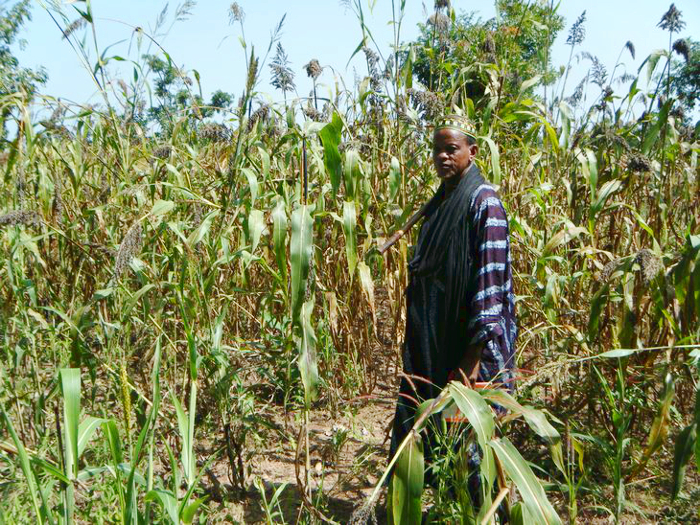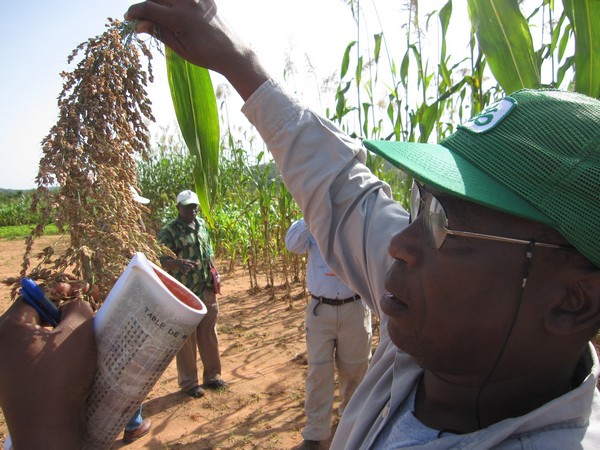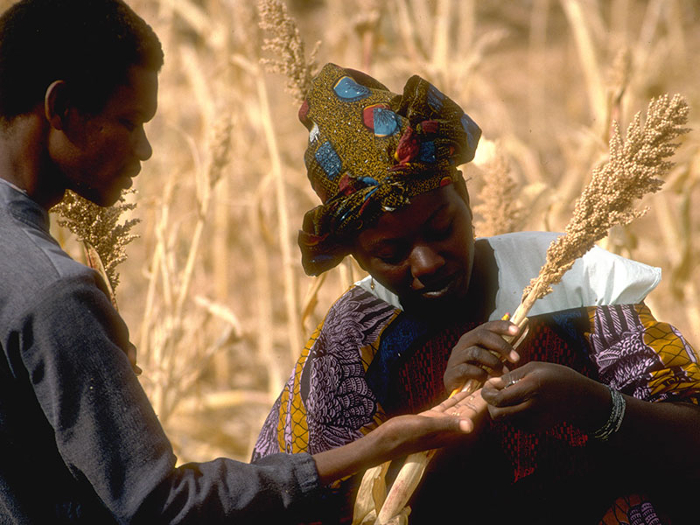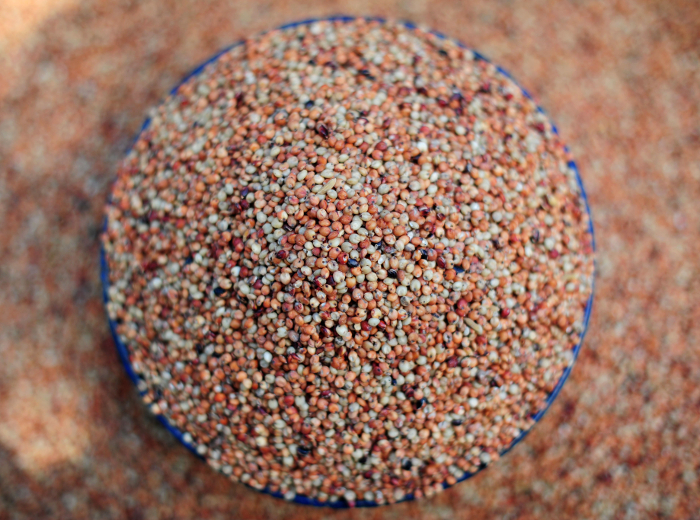“I can’t talk enough about the positive stories from the Generation Challenge Programme [GCP]. It initiated something new. I cannot measure its benefits for my country, for myself and for the sorghum-breeding and -producer communities. Right now, GCP has reached its sunset; but for me it is a sunrise, because what we have been left with is so very important.”
Growing up in a farming community in Mali, on the southern edge of the Sahara Desert, plant breeder Niaba Témé knows the ups and downs of farming in the harsh, volatile semiarid regions of Africa.
“I used to love harvesting the millet and helping my mother with her groundnut crops,” he remembers fondly. “We grew other dryland crops too, like sorghum, cowpeas, Bambara nuts, sesame and dah.”
Niaba’s village of Yendouma-Sogol is one of many villages balanced along the edge of the Bandiagara escarpment – 150 kilometres of sandstone cliffs soaring hundreds of metres above the sandy plains below. The region is considered one of the most challenging places in the world to be a farmer. The climate is harsh, with the average daily temperature on the dry, sun-scorched plains rarely falling below 30°C and often exceeding 40°C during the hottest months of the year. With no major water source available for drinking, cropping and livestock husbandry, the threat of drought is ever-present here, as it is across much of Africa’s semiarid landscape.
While much of Mali’s irrigated agriculture relies on water from the River Niger, villages like Niaba’s depend entirely on the 500 or so millimetres of rainfall they receive during the July–August wet season. In the years that the rains didn’t come, Niaba’s family were unable to harvest anything at all. The repeated failure of his parents’ crops – coupled with a natural interest in science – inspired Niaba to embark on a career where he could help farming families like his own defend themselves against the risks of drought and extreme temperatures.
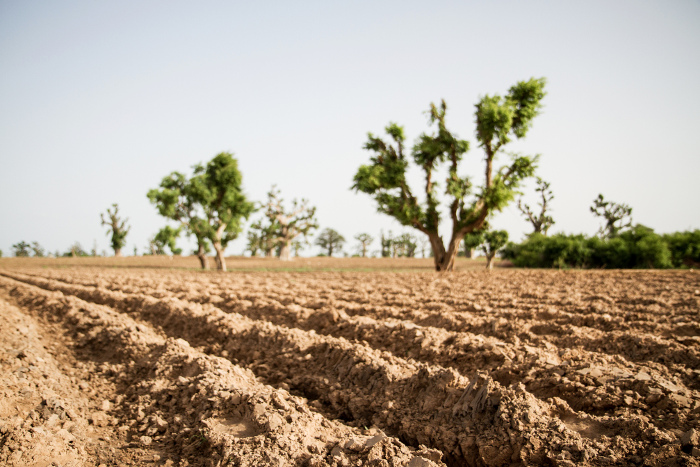
Farmland in Diouna, Mali. Farmers here must contend with the Sahel’s dry, sandy soil and whatever limited rainfall the clouds bring to grow sorghum, millet, maize, and other crops.
Niaba’s journey
Niaba’s first big step along the research road was when he enrolled to study agronomy at Mali’s Institut Polytechnique Rural de Formation et de Recherche Appliquée in Eastern Bamako. Within two years he was offered a scholarship to study plant breeding at the International Crops Research Institute for the Semi-Arid Tropics (ICRISAT) in Hyderabad, India. He then worked at the Cinzana Research Station in Mali.
Niaba later spent 11 years in the USA completing a bachelor’s degree, master’s degree and finally PhD in agronomy at Texas Tech University before returning home to Mali in 2007, where he was soon recruited by Mali’s Institut d’Économie Rurale (IER) to take charge of their new biotechnology lab at the Centre Régional de Recherche Agronomique.
His journey with the Generation Challenge Programme began in 2010 when IER received GCP funding to carry out sorghum research in Africa as part of GCP’s Sorghum Research Initiative (RI) launched that same year. The project was a collaboration with ICRISAT and France’s Centre de coopération internationale en recherche agronomique pour le développement (Agropolis–CIRAD; Agricultural Research for Development). With an initial focus on Mali, the project’s results would expand to encompass five other countries in the Sudano-Sahelian region: Burkina Faso, Ethiopia, Kenya, Niger and Sudan.
Sorghum the survivor gets even tougher
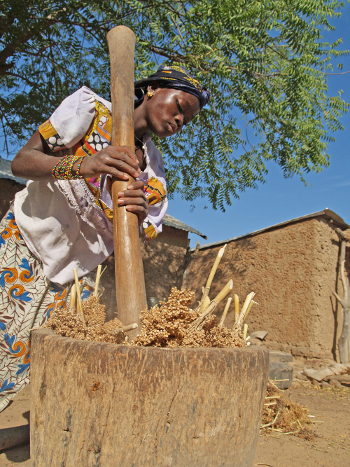
Hand milling of sorghum grains – an arduous task, mostly carried out by poor women in the drylands of Africa.
Drought-hardy crops such as sorghum are ideal for Mali’s conditions, where more water-intensive crops such as maize simply cannot survive. Millions of poor rural people across Africa depend on sorghum in their day-to-day lives: it is eaten in many forms, used to make alcoholic beverages and as animal fodder, and is converted into biofuel for cooking.
But even sorghum has its limits. While the demand for it has doubled in West Africa in the last 20 years, productivity has generally remained low, with an average yield of only one tonne per hectare for traditional varieties in Mali. This is mostly due to post-flowering drought, poor soils and farming conditions, and limited access to quality, high-yielding seed. As rainfall patterns become increasingly erratic and variable across the world, scientists warn of the need to improve sorghum’s broad adaptability to drought, to ensure future food security in Africa.
The GCP Sorghum RI, with Niaba’s help, aimed to support the development of new breeds of sorghum that could survive better on less water in drought-stricken parts of Africa. It sought to improve sorghum yield and quality for African farmers and, in turn, improve the livelihoods and food security of communities across sub-Saharan Africa.
In 2012, Niaba found himself travelling once again, this time to Australia with IER colleague Sidi B Coulibaly. They spent three weeks working alongside, and training with, Andrew Borrell and his sorghum research team at the Queensland Government Department of Agriculture, Fisheries and Forestry’s (DAFF) Hermitage Research Facility in Warwick.
“We have been collaborating with researchers at DAFF and The University of Queensland since 2009, to introduce what is called the ‘stay-green’ drought-resistant gene into our local sorghum varieties,” says Niaba.
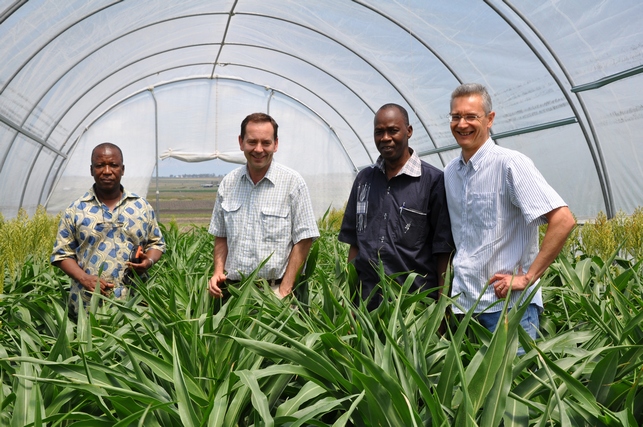
Left to right: Niaba Témé with David Jordan (Australia), Sidi B Coulibaly (Mali) and Andrew Borrell (Australia), visiting an experiment at Hermitage Research Facility in Queensland, Australia.
Niaba’s no longer green when it comes to using stay-green
Stay-green is a drought adaptation trait that allows sorghum plants to stay alive and maintain green leaves for longer during post-flowering drought. This means the plants can keep growing and produce more grain in drier conditions. It has contributed significantly to an increase in sorghum yields, using less water, in north-eastern Australia and southern USA for the last two decades.
GCP’s stay-green project aimed to evaluate the potential for introducing stay-green into Mali’s local sorghum varieties, enriching Malian pre-breeding material for the trait, and training African sorghum researchers, such as Niaba, in the methods of improving yields and drought resistance in sorghum breeding lines from both Australia and Mali.
“In Australia we learnt about association mapping, population genetics and diversity, molecular breeding, crop modelling using climate forecasts, and sorghum physiology,” says Niaba.
Learning to use molecular markers was particularly exciting, he says, “because molecular markers make it easier to see if the plant being bred has the gene related to drought tolerance, without having to go through the lengthy process of growing the plant to maturity and risk missing the trait through visual inspection.”
Niaba says the molecular training he received in Australia complemented previous training he had received through a collaborative GCP-funded project with Agropolis–CIRAD and Syngenta Foundation for Sustainable Agriculture, in which he learnt to use molecular markers to identify and monitor key regions of sorghum’s genome in consecutive breeding generations through a process called marker-assisted recurrent selection (MARS).
A large part of GCP’s focus is building such capacity among developing country partners to carry out crop research and breeding independently in the future, so they can continue developing new varieties with drought adaptation relevant to their own environmental conditions.
“Our time in Australia was an intense but rewarding experience, more so for the fact that between the efforts of Australia and Mali, we have now developed new drought-tolerant crops which will enhance food security for my country,” says Niaba. “Similarly with the help of Agropolis–CIRAD and Syngenta, we are using molecular markers to improve breeding efficiency of sorghum varieties more adapted to the variable environment of Mali.”
Sorghum sunrise in Mali
On the back of the MARS project, Niaba successfully obtained GCP funding in 2010 to carry out similar research with Agropolis–CIRAD and collaborators in Africa at ICRISAT.
“In that project, we were trying to enhance sorghum grain yield and quality for the Sudano-Sahelian zone of West Africa using the backcross nested association mapping (BCNAM) approach,” explains Niaba. “This involved using an elite recurrent parent that is already adapted to local drought conditions. The benefit of this approach is that it can lead to detecting elite varieties much faster.”
The approach has the potential to halve the time it takes to develop local sorghum varieties with improved yield and adaptability to drought. The project developed 100 lines for 50 populations from backcrosses carried out with 30 recurrent parents. The lines are now being validated in Mali.
Niaba says such successful collaborations and capacity development opportunities have been made possible only through GCP support.
“We had some contacts before, but we didn’t have the funds or skills to really get into a collaboration. Now we’re motivated and are making connections with other people so we can continue working with the material we have developed.
“GCP’s time may be ending, but it very much represents a new day – a sunrise for the work we are doing with sorghum here in Mali.”
More links
- On GCP’s regular blog: Niaba’s story | sorghum projects | all sorghum posts
- Sorghum Research Initiative | InfoCentre | slides (on SlideShare)
- Projects: stay-green | MARS | BCNAM









